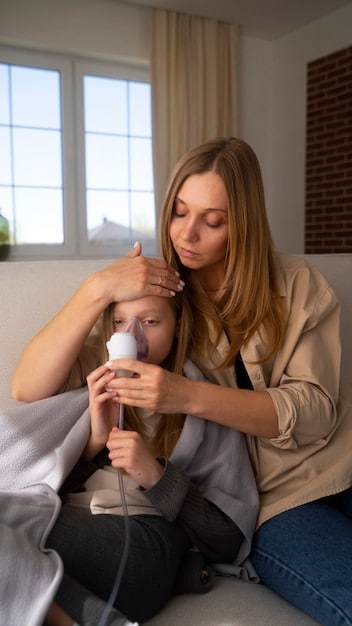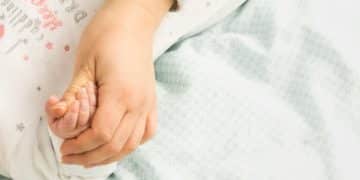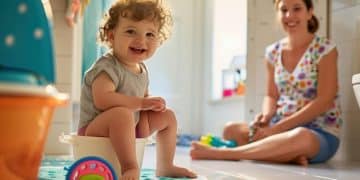Baby’s First Cold: A Parent’s Guide to Symptoms and Relief

Baby’s first cold can be distressing for both the infant and parents; understanding the symptoms, providing comfort, and knowing when to seek medical advice are crucial for managing the illness effectively.
Witnessing your baby’s first cold can be a worrying experience. This comprehensive guide offers practical advice and effective strategies to help you navigate through the symptoms, provide comfort, and ensure your little one recovers quickly.
Understanding Baby’s First Cold
It’s almost inevitable that your baby will catch a cold, typically caused by viruses. Understanding what to expect can help you prepare and react effectively.
Common Cold Causes
Colds in babies are usually caused by viruses, such as rhinoviruses. These viruses spread easily through the air when someone coughs or sneezes.
Recognizing the Symptoms
Being able to identify the symptoms early can help you manage your baby’s discomfort effectively.
- Runny or Stuffy Nose: This is often the first sign of a cold. The discharge may start clear and then become thicker and yellow or green.
- Mild Fever: A slight increase in body temperature is common, but monitor it closely to ensure it doesn’t become too high.
- Sneezing and Coughing: These are the body’s ways of trying to get rid of the virus.
- Irritability and Restlessness: Babies may become fussier than usual, especially when trying to feed or sleep.
Note: It’s important to differentiate between a common cold and more serious conditions like the flu or respiratory syncytial virus (RSV). Contact your pediatrician if you’re concerned.
Understanding the common causes and being vigilant about the symptoms can help in managing your baby’s discomfort during their first cold. Early recognition is key to providing appropriate care and comfort.
Providing Comfort and Relief
When your baby has a cold, your primary goal is to make them as comfortable as possible while their body fights off the virus.

Saline Drops and Nasal Aspiration
Using saline drops followed by nasal aspiration is an effective way to relieve nasal congestion.
How to Clear Nasal Congestion
Clearing a stuffy nose can make it easier for your baby to breathe and feed.
- Saline Drops: Place a few drops in each nostril to loosen the mucus.
- Nasal Aspirator: Gently suction the mucus out using a bulb syringe or nasal aspirator.
- Frequency: Do this before feedings and before bedtime to help your baby breathe easier.
Tip: Always clean the aspirator thoroughly after each use to prevent the spread of germs.
Providing comfort and relief involves simple yet effective techniques to ease nasal congestion and promote rest. These measures help your baby feel more at ease during their illness.
Creating a Comfortable Environment
The environment in which your baby recovers can significantly impact their comfort and recovery process.
Humidify the Air
Using a humidifier can help keep the nasal passages moist, making it easier for your baby to breathe.
Maintaining Optimal Humidity
Dry air can exacerbate congestion and discomfort. Follow these tips:
- Cool Mist Humidifier: Place a cool-mist humidifier in your baby’s room to help keep the air moist.
- Cleaning: Clean the humidifier regularly to prevent mold and bacteria growth.
- Alternative: If you don’t have a humidifier, a steamy bathroom can provide temporary relief.
Elevate the Head
Elevating your baby’s head can help drain nasal passages and reduce coughing.
Caution: Never place pillows or other soft objects in your baby’s crib, as they pose a suffocation risk.
Creating a comfortable environment involves ensuring the air is moist and your baby’s head is slightly elevated to ease breathing. These adjustments can contribute to a more restful recovery.
Ensuring Proper Hydration
Hydration is crucial when your baby has a cold, as it helps to thin mucus and prevent dehydration.
Frequent Feedings
Offer breast milk or formula more frequently to keep your baby hydrated.
Signs of Dehydration
Recognizing dehydration is important for taking prompt action.
- Fewer Wet Diapers: A significant decrease in the number of wet diapers can indicate dehydration.
- Dry Mouth: Check for dryness in your baby’s mouth and tongue.
- Sunken Fontanelle: The soft spot on your baby’s head may appear sunken.
Note: If you suspect your baby is dehydrated, contact your pediatrician immediately.
Ensuring proper hydration by offering frequent feedings and being vigilant for signs of dehydration is essential for your baby’s recovery. Early detection and action can prevent more serious complications.
When to Seek Medical Advice
Knowing when it’s necessary to seek professional medical advice can ensure your baby receives the appropriate care.

High Fever
A high fever, especially in young babies, warrants immediate medical attention.
Danger Signs to Watch For
Certain symptoms indicate the need for prompt medical evaluation.
- Difficulty Breathing: Look for rapid breathing, wheezing, or retractions (when the skin between the ribs pulls in with each breath).
- Blue Lips or Face: This indicates a lack of oxygen and requires immediate medical attention.
- Persistent Cough: If the cough is severe and persistent, it could indicate a more serious condition like bronchitis or pneumonia.
- Refusal to Feed: If your baby refuses to feed or is unable to keep down fluids, it could lead to dehydration.
Important: Trust your instincts. If you are concerned about your baby’s condition, it’s always best to consult with a healthcare professional.
Knowing when to seek medical advice involves being alert to critical symptoms and trusting your parental instincts. Prompt medical intervention can prevent complications and ensure your baby’s well-being.
Preventing the Spread of Germs
Taking preventive measures can help protect your baby and other family members from catching a cold.
Hygiene Practices
Good hygiene is essential in preventing the spread of cold viruses.
Effective Hygiene Steps
Implementing these measures can significantly reduce the risk of infection.
- Frequent Handwashing: Wash your hands regularly with soap and water, especially after touching your face, nose, or mouth.
- Avoid Close Contact: Limit close contact with individuals who are sick.
- Clean and Disinfect: Regularly clean and disinfect surfaces that are frequently touched, such as toys and doorknobs.
Vaccination
Ensure that your baby is up-to-date on all recommended vaccinations, as some vaccines can prevent illnesses with cold-like symptoms.
Note: While there is no vaccine for the common cold, the flu vaccine can help protect against influenza, which can sometimes mimic cold symptoms.
Preventing the spread of germs through diligent hygiene practices and ensuring up-to-date vaccinations are key to protecting your baby and family from infections. These preventive measures contribute to a healthier environment.
| Key Aspect | Brief Description |
|---|---|
| 🤧 Symptoms | Runny nose, mild fever, sneezing, irritability. |
| 💧 Relief | Saline drops, nasal aspiration, humidified air. |
| 🩺 When to Seek Advice | High fever, difficulty breathing, refusal to feed. |
| 🧼 Prevention | Frequent handwashing, avoiding sick contacts, disinfecting surfaces. |
Frequently Asked Questions
▼
Common colds usually involve mild symptoms like a runny nose and low fever. Serious signs like difficulty breathing or blue lips warrant immediate medical attention.
▼
Over-the-counter cold medicines are generally not recommended for babies and young children without consulting a doctor. Use saline drops and a nasal aspirator instead.
▼
You can use saline drops and a nasal aspirator as needed, especially before feedings and bedtime, to help clear nasal congestion and make breathing easier.
▼
Frequent handwashing, avoiding close contact with sick individuals, and ensuring your baby is up-to-date on vaccinations can help prevent the spread of germs.
▼
Most colds resolve within a week. If symptoms persist or worsen, consult your pediatrician to rule out secondary infections or other underlying conditions.
Conclusion
Navigating your baby’s first cold can be challenging, but with the right knowledge and care, you can help your little one recover comfortably. Remember to monitor symptoms closely, prioritize comfort measures, and seek professional medical advice when needed to ensure their well-being.





